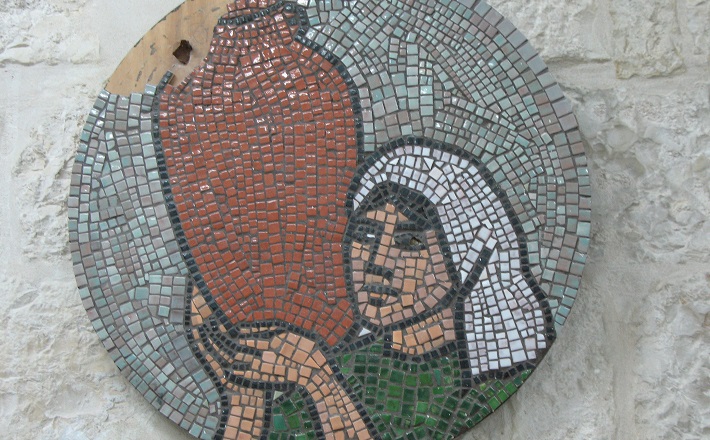Commentary on John 2:1-11
Wine often marks major life moments.
Wine often accompanies celebratory cheers, and it sometimes eases heartbreak and tears. In the second chapter of John, we find Jesus’ ministry inaugurated at a wedding, where he supplies an abundance of fine wine.
I recently had the pleasure of sitting in on a unique class offered by Princeton Theological Seminary: Wine and the Bible. Rather than meeting on campus, we gathered together at the nearby Farminary, a small farm near campus that the director, Dr. Nathan Stucky, describes as “a garden of innovation” where students learn at the intersections of theology, ecology, and authentic community.1 Each week we experienced the joy of abundant wine together as we learn about ancient wine production and wine as a theme in the Bible.
A few weeks ago, Dr. Stucky invited us to read about wine as farmers (and then enjoy the wine). We started paying attention to things like the soil where the wine was grown and the weather conditions that affected the vintage. In short, we started paying attention. This perspective opened up our experience of the wine and offered us new categories to carry with us as we tasted it.
As I considered this passage where Jesus famously changes water into wine, it struck me that we could similarly read the Bible as wine-drinkers. Reading the Bible with wine in mind means paying attention to the subtleties and the layers as we read. It means carrying with us new categories and questions to facilitate a fresh experience of the story. I’d like to offer three “tasting notes” to pay attention to as we encounter John’s story of Jesus’ first sign:
- What cultural expectations surrounding hospitality sit in the background of this story, and what might that tell us about Jesus’ mission?
- What other texts might the audience think of when encountering this story, and how might that enhance our understanding of the story’s meaning?
- What power dynamics, social structures, and expectations are subverted by the story, and how might that challenge us to consider our own ways of being in the world?
Hospitality and Jesus’ mission
Given the climate, lack of clean water, large number of guests, and sustained duration of ancient wedding feasts, the lack of wine at this wedding was a serious problem. The inability to provide what the guests needed was a failure in hospitality that would bring shame on the wedding hosts. We may read the story and wonder why the family of the bride and groom failed to provide enough wine. However, it was ancient custom for guests to bring wedding gifts in the form of food and drink to share the burden of providing for such a large group. Thus, the family’s lack of wine may indicate a lack of community support in addition to their own lack of resources.
Jesus’ actions are that of a friend and faithful community member; the provision of wine is a sign of shared hospitality. Rather than serving mediocre wine near the close of the wedding (when celebrants’ senses were less keen), Jesus brings a surprising abundance of fine wine. We may draw parallels to God’s work in the world. The beginning of Jesus’ ministry marks the start of God’s work in the world that has been long-awaited. The story leads us to expect surprisingly good and abundant things to come as Jesus begins his ministry. Starting the story with a provision of wine at a wedding feast, we can see Jesus’ mission as continuing God’s work in the world that provides hospitality and a space of belonging outside of the existing honor/shame structure.
Messianic imagery and eschatological hope
The image of wine at a feast echoes “Wisdom’s Feast” in the Hebrew Bible and continues the presentation (begun in John 1) of Jesus as the Jewish figure of Wisdom (Proverb 9:1-6). Jewish prophetic literature uses the marriage metaphor for God’s covenant with Israel (Hosea 2:14-23), and the abundance of wine figures as an eschatological image of restoration, particularly for Israel (Joel 3:13, 18; Amos 9:11-15). The abundance of wine and saving the good wine for last draws upon this imagery of eschatological hope that is often coupled with messianic expectations.
Speaking of God’s promise to bring justice to all in the restoration of the Kingdom of Israel, Isaiah issues the invitation to enjoy wine without price. The invitation is accompanied by a declaration from God that the word that goes out from God’s mouth will not return empty but will accomplish God’s purposes (Isaiah 55:1-11). It’s hard not to see the resonances with the Prologue, where Jesus is described as God’s Word who is coming into the world to make God known.2
Reversal of Expectations
This story plays on the motif of insiders and outsiders and reverses expectations regarding who fits into those categories. This first sign of Jesus’ glory is revealed to just a few, and it is not who we would expect. We might expect the groom or the bride to play a key role here, noticing how Jesus has saved their family from shame — but they obliviously enjoy the wine. We might expect important guests to have inside information about where this good and abundant wine came from, but it is the servants who get a sneak peek at Jesus’ glory in this story.
Isaiah’s imagery of a free feast with an open invitation to all (Isaiah 55:1-2) reminds us that from the beginning, God’s work for Israel would be work for the world at large. While Messianic expectations often focused on political redemption and independence for the nation of Israel, God’s “love for David” (Isaiah 55:3) was intended to draw in other nations (Isaiah 55:4-5). After another famous act of hospitality where Jesus washes his disciples’ feet, John famously commands that those who follow Jesus should “love one another” (John 13:31-35). The Gospel’s story shows that the goal of this love is that the whole world might be reconciled to God (John 17:20-23). God’s abundant provision of life goes beyond the anticipated boundaries.
Additional Resources:
- Brant, Jo-Ann. John. Paideia. Grand Rapids: Baker Academic (2011).
- Brown, Raymond E. The Gospel according to John I-XII. Anchor Bible 29. New York: Doubleday (1966).
- Malina, Bruce J. and Richard L. Rohrbaugh. Social-Science Commentary on the Gospel of John. Minneapolis: Fortress (1998).
Notes:
- “Vision – Farminary,” Princeton Theological Seminary, http://farminary.ptsem.edu/vision-why-farminary/
- The LXX of Isaiah uses the word rema, while John uses logos.


January 20, 2019